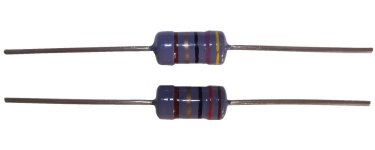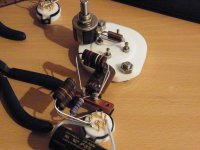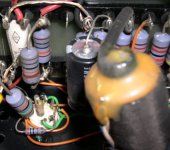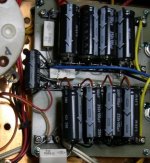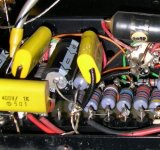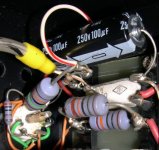SHINKOH resistors
Hificollective.com in the UK
100 $ + shipping + PayPal for 4 pcs NOS resistors, please?
Hificollective.com in the UK
100K Shinkoh is almost impossible to find these days...
You could however parallel 160K 1watt and 330K 1watt and it would give you ~107K 2watts. You can use a parallel resistor calculator online to figure it out.
Parallel Resistor Calc http://www.1728.org/resistrs.htm
Or use Audio Note Tantalum 100K 2watts and save you all the trouble and money!
Ciao!
You could however parallel 160K 1watt and 330K 1watt and it would give you ~107K 2watts. You can use a parallel resistor calculator online to figure it out.
Parallel Resistor Calc http://www.1728.org/resistrs.htm
Or use Audio Note Tantalum 100K 2watts and save you all the trouble and money!
Ciao!
Last edited:
Hificollective.com in the UK
Just checked and they don't have 100K 2 watt or 100K 1 watt...
680 & 390 are available in 1W. load sharing isn't optimal and the combination makes 107K, but that should not make a world of difference in this application i'd say..
SHINKOH-72867
SHINKOH-68362
and if i'd be willing to spend 100$ on a few resistors, i'd be willing to check out if the audible difference between 107K and 100K is worth the price.
SHINKOH-72867
SHINKOH-68362
and if i'd be willing to spend 100$ on a few resistors, i'd be willing to check out if the audible difference between 107K and 100K is worth the price.
The original Ongaku schematic we may find here http://www.enjoythemusic.com/magazine/sound_practices/2/ongaku/ongaku_schematic.pdf
In the anode resistor position of the 1st half of the 5687 there are two pcs 100kOhm/2W per channel. They are working paralell (50kOhm/4W). So the minimum power what I need is 4W. This very signal position is quite sensitive for the final sound.
I have same values of AN tantalum resistors, as we can see in the attached picture. Because of better and closer to the original Ongaku's sound quality I need Shinkoh ones. Used resistors are no problem.
Btw thx for previous comments indeed.
In the anode resistor position of the 1st half of the 5687 there are two pcs 100kOhm/2W per channel. They are working paralell (50kOhm/4W). So the minimum power what I need is 4W. This very signal position is quite sensitive for the final sound.
I have same values of AN tantalum resistors, as we can see in the attached picture. Because of better and closer to the original Ongaku's sound quality I need Shinkoh ones. Used resistors are no problem.
Btw thx for previous comments indeed.
Attachments
pinnocchio: Thx, indeed. It is the work of my friend.
Joe Roberts: You are right, I am not sure about Kondo used Shinkoh resistors. But they are some signs showing that his resistors choice was quite close to the Shinkoh.
1.) Owen Young wrote that Kondo San used Shinkoh Tantalums (2011: Best equipment purchase this year) 14 DEC 2011, 11:42 AM.
2.) I have an internal photo of original Kondo's Ongaku, where we may see these 2 parallel 100kOhm/2W Shinkoh kind of resistors. Check the picture attached bellow, please.
On other side it is clear that the original KSL Tantalum resistors are very close to the Shinkoh Tantalums, but they are hand made and have special cups and leads, made from time-annealed Kondo's silver. On top of them the metallic-crystalline structure of this silver material is not well known yet. Consequently the KSL tantalums are not only obtain the "Kondo sound", but they are really very costly at any rate to me.
My direct intention is to build an Ongaku Clone as closer as possible to the original one. Of course I have a limitation of my budget, that is why I'm not ready to pay for 4 resistors more than 100 $.
I think, after the finishing of my project I will have some free way for the final tuning of the amplifier's sound character, with special regards to the cheaper anode resistors too (e.g. Mills, Allen Bradley, Riken RMG Carbon or my existing Audio Note Tantalums), if it is necessary.
On e-bay, AudiogoN and here there are a lot of already finished, but really excellent quality tubes, capacitors and different electronic parts. Some of them even older a lot, then these Shinkoh tantalums.
Maybe somebody, who has a good heart, ready to help me indeed.
That is why I am loking for Shinkoh resistors henceforward.
Joe Roberts: You are right, I am not sure about Kondo used Shinkoh resistors. But they are some signs showing that his resistors choice was quite close to the Shinkoh.
1.) Owen Young wrote that Kondo San used Shinkoh Tantalums (2011: Best equipment purchase this year) 14 DEC 2011, 11:42 AM.
2.) I have an internal photo of original Kondo's Ongaku, where we may see these 2 parallel 100kOhm/2W Shinkoh kind of resistors. Check the picture attached bellow, please.
On other side it is clear that the original KSL Tantalum resistors are very close to the Shinkoh Tantalums, but they are hand made and have special cups and leads, made from time-annealed Kondo's silver. On top of them the metallic-crystalline structure of this silver material is not well known yet. Consequently the KSL tantalums are not only obtain the "Kondo sound", but they are really very costly at any rate to me.
My direct intention is to build an Ongaku Clone as closer as possible to the original one. Of course I have a limitation of my budget, that is why I'm not ready to pay for 4 resistors more than 100 $.
I think, after the finishing of my project I will have some free way for the final tuning of the amplifier's sound character, with special regards to the cheaper anode resistors too (e.g. Mills, Allen Bradley, Riken RMG Carbon or my existing Audio Note Tantalums), if it is necessary.
On e-bay, AudiogoN and here there are a lot of already finished, but really excellent quality tubes, capacitors and different electronic parts. Some of them even older a lot, then these Shinkoh tantalums.
Maybe somebody, who has a good heart, ready to help me indeed.
That is why I am loking for Shinkoh resistors henceforward.
Attachments
Your dedication is remarkable!
What I am saying is that there may well be various versions of Ongakus. I think Audio Note had a lot of influence on the production.
Kondo made the amp before Audio Note got involved.
Kondo doesn't say anything about resistors in his article...silver caps, transformers, copper chassis yes...resistors no!
Were Shinkoh resistors even available at that time?
You can't get the original Kondo transformers anyway so I'd say enjoy what you have and make small changes. Perhaps the best suggestion I heard is to use the Shinkohs you can get from Parts Connection.
Did you know that the original Kondo Ongaku was a feedback amp? Audio Note changed it to a no negative feedback design because they are anti-feedback.
What I am saying is that there may well be various versions of Ongakus. I think Audio Note had a lot of influence on the production.
Kondo made the amp before Audio Note got involved.
Kondo doesn't say anything about resistors in his article...silver caps, transformers, copper chassis yes...resistors no!
Were Shinkoh resistors even available at that time?
You can't get the original Kondo transformers anyway so I'd say enjoy what you have and make small changes. Perhaps the best suggestion I heard is to use the Shinkohs you can get from Parts Connection.
Did you know that the original Kondo Ongaku was a feedback amp? Audio Note changed it to a no negative feedback design because they are anti-feedback.
The overwhelming majority (90%) of my resistor assortment for Ongaku are Shinkohs now. The leftover 10% are Mills and 4 Audio Note tantalums. Even within the stepped volume controls I'm using 46 Shinkohs. So another reason why I am going to use Shinkoh is the effect of the homogenization.
Lot of people think that Shinkoh resistors are better sounding then ANs and Shinkohs are one of the best resistors in the world. So there is a question: why should I not try a better quality if I can?
I'm looking for these resistors as a functional parts only, their price is not very interesting to me. E.g. for my Ongaku, the VCap CUTF signal caps, Bendix 6900s second tubes or Black Gate WKZs in PS were significantly more expensive then the Shinkohs 2W. Even the price of 2W AN tantalums were 40% more than the price of 2W Shinkohs (PartsConnexion). It means that the functionality of these anode resistors are more improtant to me than their prices, that is why I'm looking for the best quality.
And probably I have a subjective motivation too: I would never sleep peacefully if I never proved Shinkohs in the anode positions .
.
It is my final decision, I standing to Shinkohs and I'm quite curious about the sound of them now.
Support me with a real opportunity to buy these resistors if you might, please.
Lot of people think that Shinkoh resistors are better sounding then ANs and Shinkohs are one of the best resistors in the world. So there is a question: why should I not try a better quality if I can?
I'm looking for these resistors as a functional parts only, their price is not very interesting to me. E.g. for my Ongaku, the VCap CUTF signal caps, Bendix 6900s second tubes or Black Gate WKZs in PS were significantly more expensive then the Shinkohs 2W. Even the price of 2W AN tantalums were 40% more than the price of 2W Shinkohs (PartsConnexion). It means that the functionality of these anode resistors are more improtant to me than their prices, that is why I'm looking for the best quality.
And probably I have a subjective motivation too: I would never sleep peacefully if I never proved Shinkohs in the anode positions
It is my final decision, I standing to Shinkohs and I'm quite curious about the sound of them now.
Support me with a real opportunity to buy these resistors if you might, please.
The overwhelming majority (90%) of my resistor assortment for Ongaku are Shinkohs now. The leftover 10% are Mills and 4 Audio Note tantalums. Even within the stepped volume controls I'm using 46 Shinkohs. So another reason why I am going to use Shinkoh is the effect of the homogenization.
Lot of people think that Shinkoh resistors are better sounding then ANs and Shinkohs are one of the best resistors in the world. So there is a question: why should I not try a better quality if I can?
I'm looking for these resistors as a functional parts only, their price is not very interesting to me. E.g. for my Ongaku, the VCap CUTF signal caps, Bendix 6900s second tubes or Black Gate WKZs in PS were significantly more expensive then the Shinkohs 2W. Even the price of 2W AN tantalums were 40% more than the price of 2W Shinkohs (PartsConnexion). It means that the functionality of these anode resistors are more improtant to me than their prices, that is why I'm looking for the best quality.
And probably I have a subjective motivation too: I would never sleep peacefully if I never proved Shinkohs in the anode positions.
It is my final decision, I standing to Shinkohs and I'm quite curious about the sound of them now.
Support me with a real opportunity to buy these resistors if you might, please.
Hello,
I am the owner of original Kondo-san made Ongaku. Yes you are right that he used Shinkohs in the old versions, but dont you think you have altered the sound much more with Black Gate WKZ which were never used, or Elna Silmic II capacitors that have never been used? Especially V-caps are far away from Kondo sound, you would get much closer by chosing Audio Note UK silver caps. Also cathode caps are extremely sensitive and here you must chose only one vintage type, not Black Gate or Elna...
So to summarize I think you have far more greater problems than 2-4 pcs Shinkoh resistors
mbede: I think, you are absolutely right, really. Some weaks ago I changed Silmic II caps to BG NH, but - according to your opinion - only one vintage type would be OK. May I know the type & value of this cathode caps, please. So the sound of my clone will very far from the original and never will get into close enough to the Kondo-san made Ongaku. I am embittered now and thinking about finishing of my dead project. Thx for all valuable comments of those diyAudio members, who gave me any piece of advice and opened my eyes to the reality.
mbede: I think, you are absolutely right, really. Some weaks ago I changed Silmic II caps to BG NH, but - according to your opinion - only one vintage type would be OK. May I know the type & value of this cathode caps, please. So the sound of my clone will very far from the original and never will get into close enough to the Kondo-san made Ongaku. I am embittered now and thinking about finishing of my dead project. Thx for all valuable comments of those diyAudio members, who gave me any piece of advice and opened my eyes to the reality.
Hello Zeroalbedo, do I fell sarcasm in your message? I was not trying to offend you, really. Your clone will never come really close to the real thing, because of many many reasons. If you want to know some details please PM me. BTW. the brand of capacitor on cathode bypass must be SME, no other one will sound right. BR, mbede
Imagine this: Your clone might turn out BETTER than the Ongaku.
The Kondo article was pretty good...I am not at all convinced that it is the best amp of the universe, though.
There are a lot of amps out there, including several "Genuine Ongaku" versions!
As I mentioned, the original design was a feedback amp before AN got involved. So what is "original?"
mbede...Are we talking about SME caps by United Chemi-Con? Is there a small shield next to "SME?" That was a rather generic "general purpose" cap...nothing fancy. They appear on ebay rather often. Want 50 pcs. for $7?
50pcs Nichicon SME Radial Capacitor 68uf 16v 85C NEW | eBay
If there is a rectangle next to SME instead of a shield, then these are late-version low-ESR Nichicon parts. Technically better but might not sound like the UCC caps.
The important thing is to finish the project , fire it up, and enjoy!
Forget the mythology!
The Kondo article was pretty good...I am not at all convinced that it is the best amp of the universe, though.
There are a lot of amps out there, including several "Genuine Ongaku" versions!
As I mentioned, the original design was a feedback amp before AN got involved. So what is "original?"
mbede...Are we talking about SME caps by United Chemi-Con? Is there a small shield next to "SME?" That was a rather generic "general purpose" cap...nothing fancy. They appear on ebay rather often. Want 50 pcs. for $7?
50pcs Nichicon SME Radial Capacitor 68uf 16v 85C NEW | eBay
If there is a rectangle next to SME instead of a shield, then these are late-version low-ESR Nichicon parts. Technically better but might not sound like the UCC caps.
The important thing is to finish the project , fire it up, and enjoy!
Forget the mythology!
Imagine this: Your clone might turn out
The important thing is to finish the project , fire it up, and enjoy!
Forget the mythology!
Dear Joe, yes it is an old SME, but no, required value you cannot source on ebay. I agree - one should not be bothered about it, but if you want to CLONE than this is crucial. The point to Kondo philosophy is to use off-the-shelf parts, any black gate you put in this position has an effect to lose transparency and beauty of the tone. I know, I have tried.
Of course Ongaku is not the end of universe, someone might even produce something better with 211 tube as a "clone project", why not...but Ongaku is a helluva sounding amplifier and a piece of hifi history.
Yes, Joe and mbede you are right. As I checked the very internal part of Ongaku, I found a lot of SME caps. The cathode caps value is 100uF/250V, but some caps are paralelled with I do not know what kind of yellow (foil?) caps. Even the T 501 value on their surfaces is not clear to me. The SME caps are signed by rectangles as you may check the attached photos. And yes, there are a lot of ELNA Cerafines, white block wired power resistors and Shinkohs  .
.
Thx to egg me on to finish my project.
 .
.Thx to egg me on to finish my project.
Attachments
- Status
- This old topic is closed. If you want to reopen this topic, contact a moderator using the "Report Post" button.
